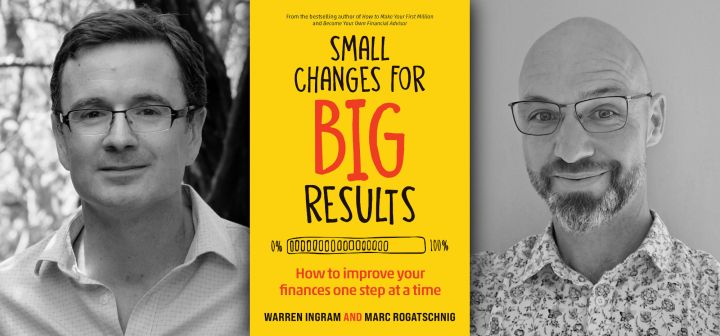BOOK EXCERPT
Running out of money every month? Here’s how to create a practical spending plan

‘Small Changes for Big Results’ provides clear, actionable steps that anyone can follow to take control of their finances and free themselves from common behavioural traps.
We all make plans for a better financial future. Unfortunately, most people never achieve their goals.
There is no shortage of good advice, personal finance books and well-worn practices, so the question is: Why can’t people change? We know what to do, but then inexplicably don’t seem to do it. What keeps tripping us up?
According to Warren Ingram, award-winning financial planner and respected personal finance commentator, and clinical and consulting psychologist Marc Rogatschnig, many of our money troubles are caused by deep-seated behavioural traps that keep us locked in a vicious cycle.
If lasting change begins with small, consistent actions, Small Changes for Big Results will equip you with the tools to make incremental changes to your finances that will yield big results over time.
Read the excerpt below.
***
How to create a practical spending plan
A common personal finance problem is that people find it difficult to save money every month. There are many reasons for this, the most obvious being that someone simply isn’t earning enough money, is living off social support or earning hourly fees for part-time work.
Personal finance writers and public speakers are painfully aware that they may not use the ‘B word’ in a book or a talk – because when they mention ‘budget’, they risk losing the audience’s attention. Of course, it won’t help anyone if we, as financial advisors, simply change the term ‘budget’ to ‘spending plan’ and hope that we can help you achieve new goals. We must help you develop a specific plan for your daily, weekly and monthly money strategies. It starts with some straightforward, small steps, but these can lead to profound change.
If you associate budgets with accountants or are uncomfortable with numbers, the mere thought of a budget may be very intimidating. You might find creating a budget incredibly daunting and believe that it is complicated. Or you might think that budgets are boring, and that tracking all your expenses every day or month is a waste of time. Or perhaps you do not feel equipped to even start.
Then there is the emotional aspect of budgeting: you may fear facing the reality that you are overspending or managing your money badly. You might fear uncovering the true extent of your unhealthy financial position, worry that you will need to change your habits and wonder how this will affect your lifestyle.
If you are one of the millions running out of money every month, you probably need an effective spending plan, which is why we have set out a practical example in this chapter.
Your financial plan
The first step towards achieving any goal is to work out exactly where you are right now. Once you have a clear idea of your current position, you can plot an efficient route to reach your destination. Knowing where you are and where you want to go is critical to any plan.
Work out where you are now
If you aim to draw up a spending plan that will help you achieve your vision, you must work out exactly how you are spending money now. First of all, get hold of a small notebook that you can keep with you all day (or use the notes function on your smartphone). If you prefer a technological solution, use a spending app to track your expenses, which requires a little more effort. Ensure that your app tracks everything you spend, as you might need to include cash expenses.
We suggest you start by simply tracking all your expenses on Mondays. Do this every Monday for a month. After a month, start to track your expenses for Monday and Tuesday, and do this for a month. After another month, track your expenses for every day of the week. By month three, you will have developed the simple habit of tracking your expenses and will have gained a much clearer understanding of where your money goes every day of the week.
Review and redirect your spending
Once you track your daily expenses for a month, you are likely to begin reviewing how you are spending your money. At this point, you can start identifying any costs that seem unimportant but make up a significant portion of your expenses. For example, do you buy coffee regularly? How much money do these coffees cost you per day, per week, per month? Once you have actual amounts for your various expenses, it becomes easier to make informed decisions about how you want to spend your money.
For example, if you love coffee and want to continue drinking it daily, can you find lower-cost ways to enjoy it? What about making coffee at home and taking it to work in an insulated travel mug? Alternatively, you might reduce the number of coffees you buy by one cup daily, so instead of buying three per day, try to buy only two.
Another budget item to consider might be takeaway food or lunches you buy at work. Takeaways can be an expensive habit and possibly unhealthy for you too. How about making meals at home and taking them to work? This will save you money and ensure that you eat healthier food.
Once you have identified the most obvious unnecessary daily expenses and have managed to reduce them, review your daily expenses again to see if there are any less obvious items that consume your money unnecessarily. How could you reduce your everyday spending on them? The critical point of having a spending plan is that it helps you to work out how you spend your money daily and helps you to feel in control. The aim is not to stop buying non-essential items entirely. Rather, it allows you to continue spending money on things that bring you joy while helping you balance your spending on luxuries and necessities to ensure your long-term financial well-being. A great spending plan always caters for items that bring you joy.
Once you have refined your spending plan to the point where you spend less than you earn every month, you should start a monthly transfer from your bank account into a separate cash account. This is the holy grail of personal finance. The amount you transfer should be the gap between your income and your expenses.
Set up an emergency fund
Your goal now is to build up this account over a year (or longer) to the point where the amount will be enough to cover your monthly expenses for three months. The purpose of this account is to have money on hand to pay your running costs if you were to lose your job. This is called an emergency fund.
It is your most important step towards securing financial freedom. Your emergency fund is there purely to protect you against an unplanned event that could derail your financial plan. It is not part of your holiday savings or fun money. It is the money you use when life goes wrong and you need funds to get through the month. The real advantage of an emergency fund is that it helps you avoid having to borrow money at short notice during a financial crisis.
Whenever you need to borrow money at short notice, avoid using facilities such as your credit card, your overdraft, a personal loan or a micro-loan, which all charge incredibly high interest rates and often have onerous terms and conditions. An emergency fund may not be your best investment, but it will be your best tool to avoid these expensive forms of finance. It is the best financial gift you can give yourself.
However, the ultimate financial goal for most people is to achieve financial freedom. This book would be incomplete if we did not expand on financial freedom and what it can mean for you.
Aim for financial freedom
A simple explanation of financial freedom is having enough money invested to earn sufficient income to cover your monthly costs. This means that you no longer need to work to pay your bills. It is a concept that differs markedly from retirement, which entails stopping work altogether.
You can achieve financial freedom and still continue to work because it is your choice. When you work out of choice, you often find more meaning and purpose in what you do.
Financial freedom is possible for anyone. If you keep your expenses low, you won’t need much investment money to cover your monthly costs. There is a vast difference between being wealthy and being financially free. To be truly rich, you must work hard and be lucky to succeed. Luck is the reason why only a few people will ever be truly rich. The founders of Microsoft, Amazon, Alibaba, Tencent and Facebook were brilliant people. However, they were also lucky enough to be born at the right time and in the right place for them to launch their businesses. Consider what would have happened to these people if they had been born in Myanmar, North Korea or Sudan – would they have been able to achieve the same success?
It is also essential to understand that you can be wealthy but not financially free. Consider a family that is worth R5 million. Assume that the family spends R500 000 annually to maintain their lifestyle. This means that they are spending 10 per cent of their wealth every year. If they don’t work to earn extra money, they will be bankrupt within a few years. Now consider another family worth only R2 million, but which spends only R100 000 yearly. This means that they are only spending 5 per cent of their wealth. This level of spending is sustainable: they won’t need to work to pay their bills because they have achieved financial freedom. It is much easier to build up investments of R2 million than R5 million, and this is why financial freedom is possible for anyone. You don’t need to be rich to cover your expenses if you can keep your costs low.
Thousands of people have achieved financial freedom. They come from many different countries and have different education levels. Very few inherited any money or received a financial education from their parents. While they differ in many respects, most can control their spending to ensure that they spend less than they earn every month. In summary, they control their money and don’t let their money control them. DM
Small Changes for Big Results: How to Improve Your Finances One Step at a Time by Warren Ingram and Marc Rogatschnig is published by Penguin Random House SA (R290). Visit The Reading List for South African book news, daily – including excerpts!
















Comments - Please login in order to comment.